Data structures and algorithms are two of the core elements of a large and complex software project. They are a systematic way of storing and organizing data in software so that it can be used efficiently. Python has efficient high-level data structures and an effective object-oriented programming language. Python is the language of choice for many advanced data tasks, for a very good reason. It is one of the easiest advanced programming languages to learn. Intuitive structures and semantics mean that for people who are not computer scientists, but maybe biologists, statisticians, or the directors of a start-up, Python is a straightforward way to perform a wide variety of data tasks. It is not just a scripting language, but a full-featured, object-oriented programming language.
In Python, there are many useful data structures and algorithms built into the language. Also, because Python is an object-based language, it is relatively easy to create custom data objects. In this book, we will examine Python's internal libraries and some of the external libraries, and we'll learn how to build your own data objects from first principles.
In this chapter, we will look at the following topics:
- Obtaining a general working knowledge of data structures and algorithms
- Understanding core data types and their functions
- Exploring the object-oriented aspects of the Python programming language


